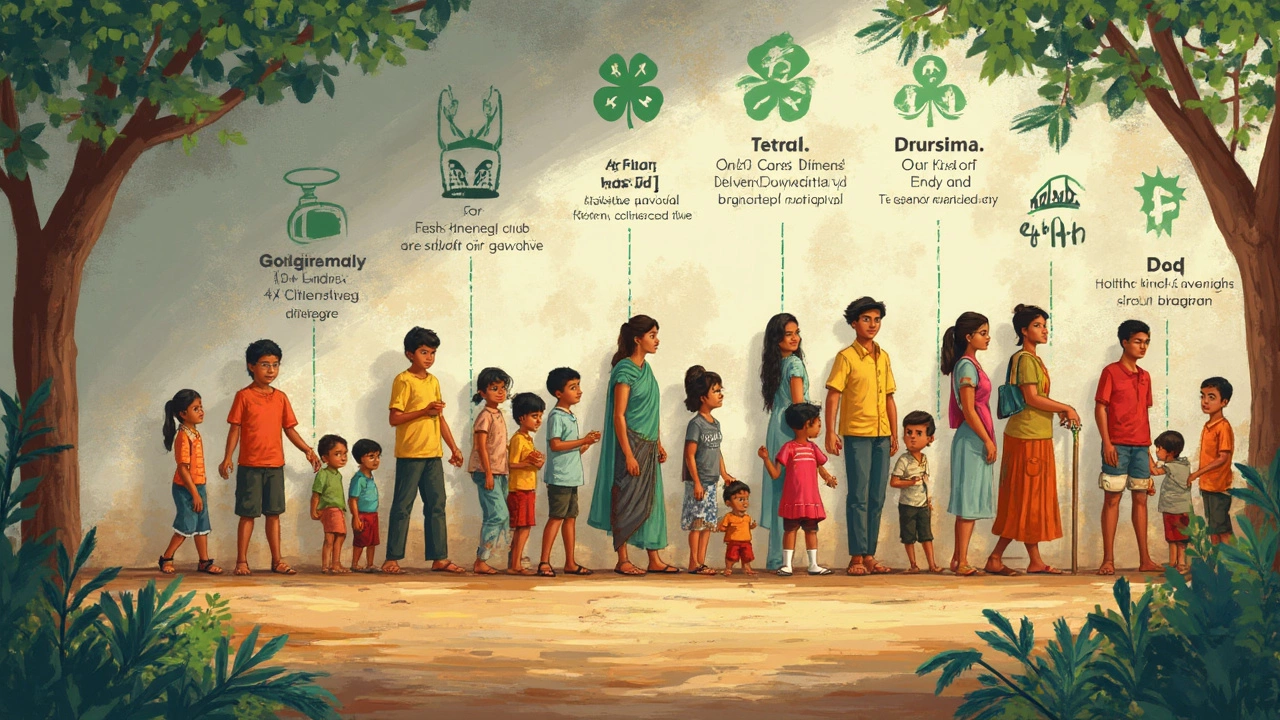Ever noticed that kids wearing 4-H T-shirts seem to know some secret club handshake you don’t? The name 4-H actually isn’t a mystery, though. Each H stands for something important: Head, Heart, Hands, and Health. These four words are the backbone of a group that’s shaped millions of kids in the U.S. and way beyond.
Before you shrug it off as an old-fashioned farming club, here’s the thing—4-H members aren’t just learning to show a pig at the county fair. These days, you’ll find kids in robotics, coding workshops, gardening, public speaking, and even cooking competitions (my friend’s kid created a three-course meal that would put most restaurants to shame). If you’re a parent eyeing something that’ll actually help your child build skills—not just a line on a college app—4-H is pretty hard to beat.
- The Four H’s Explained
- A Brief History of 4-H
- What 4-H Clubs Do Today
- Surprising 4-H Facts
- Joining 4-H: Tips for Parents and Kids
The Four H’s Explained
So, what does 4-H actually stand for? The letters each have a specific meaning, and together, they spell out the entire purpose of the club. Here’s the quick breakdown:
- Head—Thinking clearly, making good decisions, and solving problems. This is where the learning part kicks in, from science projects to leadership roles. Kids are encouraged to use their "head" to try out new ideas, challenge themselves, and figure stuff out on their own.
- Heart—Acting with kindness, loyalty, and empathy. It’s about relationships, teamwork, and showing care for others. 4-H really leans into creating a community that feels safe and supportive, so kids not only learn new things—they learn to treat people right too.
- Hands—Getting involved, trying skills, and helping others. This part is all about action: volunteering, trying new hobbies, or even fixing things. When you see 4-H members helping out at local fairs or parks, you’re seeing this “H” in action.
- Health—Taking care of yourself physically and mentally. From healthy cooking classes to sports and mindfulness activities, 4-H wants young people to grow up strong and balanced. They’re taught that health matters, not just for themselves but for their whole community.
The official 4-H pledge ties all this together:
- My head to clearer thinking,
- My heart to greater loyalty,
- My hands to larger service,
- My health to better living, for my club, my community, my country, and my world.
If you think it’s just buzzwords, think again. 4-H has been around for over a century, and those four H’s still show up in everything they do. Here’s a peek at what each H actually translates to for members today:
| 4-H Word | What It Teaches | Examples in Action |
|---|---|---|
| Head | Critical thinking, goal setting | STEM projects, public speaking contests |
| Heart | Empathy, teamwork | Clubs, service learning, making friends |
| Hands | Practical skills, community involvement | Cooking, community cleanups, building projects |
| Health | Wellness, self-care | Nutrition classes, sports, mindfulness workshops |
The 4-H approach is pretty direct: help kids grow into capable, kind, skilled people—inside and out. That mix of learning, doing good, and staying healthy? That’s the secret sauce.
A Brief History of 4-H
4-H goes way back—over a hundred years, in fact. It started popping up around 1902 in small towns across the Midwest. The idea was simple but brilliant: let kids learn by doing, instead of just sitting in a classroom all day. School teachers and farm agents noticed kids picked up farming techniques faster than adults, so they created “corn clubs” and “tomato clubs” where kids could experiment themselves.
The first official 4-H club kicked off in 1902 in Clark County, Ohio, led by a school superintendent, A.B. Graham. He rallied a bunch of students to work on hands-on agriculture projects, and it worked—soon kids were out-producing their parents in the field! These activities got so popular, they spread across the country.
By 1914, Congress passed the Smith-Lever Act, which created Cooperative Extension Services at land-grant universities. This meant support and money for what quickly became known as 4-H clubs. Here’s why: the four “H” words were added to describe what they wanted kids to develop—Head, Heart, Hands, and Health.
| Year | Key Milestone |
|---|---|
| 1902 | First recognized 4-H clubs formed in Ohio |
| 1914 | Smith-Lever Act funds youth clubs through universities |
| 1924 | “4-H” becomes the official name |
| 1927 | The 4-H pledge is adopted |
| 1952 | 4-H marks its 50th anniversary |
| 2023 | 4-H serves nearly 6 million young people in the U.S. alone |
4-H no longer sticks to just farming. By the 1950s, clubs included science, leadership, and citizenship activities. Today, there are 4-H kids in big cities, suburbs, and rural towns. The program keeps evolving, but “learning by doing” is still at the heart of everything.

What 4-H Clubs Do Today
Forget the stereotype that 4-H is just about farm animals and blue ribbons. Today’s 4-H clubs are all about hands-on projects, teamwork, and learning real-world skills. The program reaches about six million young people in the U.S. each year, and those members come from the city, the suburbs, and rural areas—so it’s not just for kids living on a farm.
Members work in small clubs led by local volunteers. These groups choose specific projects to focus on during the year, with kids picking anything from raising rabbits, fixing bikes, computer coding, to environmental science, art, and even financial literacy. 4-H sponsors national challenges in STEM fields, like the National Youth Science Day, where clubs across the country solve a real-world problem together. There are also cooking, photography, and leadership projects. Whatever sparks a kid’s interest, there’s likely a 4-H activity for it.
"4-H empowers young people with the skills to lead for a lifetime. We focus on experiential learning—where youth actually do the work and learn from the outcome, not just listen to a lesson." – Jennifer Sirangelo, President & CEO, National 4-H Council
Meetings mix social time, project planning, and community service. Kids might organize a roadside clean-up, lead a tech workshop for seniors, or team up for a local food drive. It’s not all talk—there’s action and plenty of it.
You might be surprised by some of the modern programs and competitions offered:
- Robotics and coding clubs using LEGO Mindstorms or Arduino kits
- Healthy living challenges with cooking and fitness competitions
- Public speaking and debate tournaments
- Gardening and environmental science research (with real experiments!)
- Annual camps and leadership conferences attended by thousands of kids nationwide
To give you a clearer picture, here's a quick look at what’s happening in 4-H across the country:
| Popular 4-H Projects | Number of Participants (2024) |
|---|---|
| STEM & Robotics | 1.4 million |
| Animal Science | 850,000 |
| Healthy Living | 980,000 |
| Citizenship & Leadership | 1.2 million |
So whatever your kid is into, chances are 4-H has something to offer. There’s room to try new skills, screw up a little, and have a ton of fun along the way.
Surprising 4-H Facts
Think 4-H is just cows and corn? There’s so much more to it. Over 6 million young people across the U.S. sign up for 4-H activities every year, making it the largest youth development organization in the country. That’s more than the Boy Scouts and Girl Scouts combined. You’ll even find 4-H programs in more than 50 countries around the globe, including places you wouldn’t expect—like Ghana, Armenia, and South Korea.
The first 4-H clubs popped up over a century ago, back in 1902! The original goal was straightforward: Teach kids modern farming methods and let them bring new ideas home to their communities. Sound old school? Maybe, but 4-H has evolved with the times. These days, national 4-H contests cover everything from drone navigation to coding and digital photography. You probably didn’t know that the first female astronaut, Sally Ride, was a 4-H kid. So was Julia Roberts. The program isn’t just for future farmers—it's for future leaders, scientists, and creators, too.
- Each year, 4-H hands out nearly $3 million in college scholarships. Don’t sleep on the chance–my cousin scored a big one because of her 4-H science project!
- The famous clover emblem with the four H’s is even protected by an Act of Congress. It’s as official as the Olympic rings or the Red Cross symbol.
- National 4-H Week is celebrated every October. Expect to see parades, fun runs, cook-offs, and lots of green everywhere.
Just to put things in perspective, here’s a quick breakdown:
| Stat | Details |
|---|---|
| Annual U.S. youth enrolled | 6 million+ |
| Countries with 4-H programs | 50+ |
| Years in existence | 123 |
| Annual scholarships awarded | $3 million |
So next time you hear about 4-H, remember it’s way bigger and more diverse than most people guess. Even if farm animals aren’t your thing, there’s a spot for every interest—from science and engineering, to fashion, to game design.

Joining 4-H: Tips for Parents and Kids
If you’re thinking about taking your family into the world of 4-H, here’s what you need to know—no guesswork.
First up, your child doesn’t have to live on a farm or have experience with animals. 4-H welcomes kids from all backgrounds. The club has spots for anyone aged 5 to 18, and in 2024 alone, over 6 million kids in the U.S. joined a 4-H program. Kids join ‘clubs’, which can meet at schools, community centers, or even virtually.
Here’s what you can do to get started:
- Find Your Local 4-H: Check your state’s 4-H website or the USDA 4-H map. Most counties have their own Extension Office making it super easy to find one nearby.
- Pick a Project: From robotics to cooking to gardening, there are dozens of projects. Let your kid pick what actually excites them—they’ll want to show up!
- Sign Up: Signups usually involve a parent filling out some forms (often online these days) and paying a small annual fee. Plenty of support is available if cost is an issue.
- Show Up to a Meeting: This is key. Attend an intro meeting so your child can meet club leaders and other kids, and get a sense of how things run.
Don’t expect it to be just about signing up and sitting in a room. 4-H clubs work on real-world projects, compete in events, and even travel for state or national conferences. Did you know 4-Hers have gone on to win top science and engineering scholarships? NASA has even hired former 4-H members straight out of college.
| Age Group | Program Name | Estimated Annual Fee (2024) |
|---|---|---|
| 5-7 | Cloverbuds | $10–$30 |
| 8-18 | 4-H Youth Membership | $20–$50 |
If your child likes it, encourage them to try different projects over time. 4-H isn’t a one-and-done thing. It’s more like a choose-your-own-adventure, year after year. And for parents—don’t worry, you’re not signing up to run the show. But volunteers and helpers are always welcome if you want to be involved.
